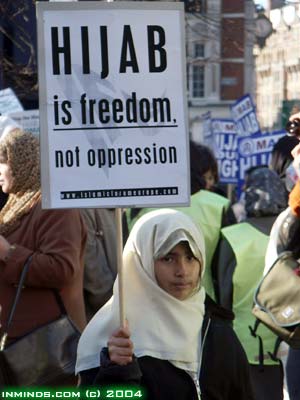According to Leila Ahmed's book Gender and Women in Islam...
1.
Muslims did not invent the veil.
2.
Veiling was practiced in:
Sasanin soceity,
the Christian Middle East,
and the Mediterranean
during and proceeding the rise of Islam
3.
Muhammad did NOT require women to veil.
I understand, that even though Muslims did not invent the veil, women wearing the veil often identify as Muslim. While Christians may have once practiced veiling, they generally do not veil today. (Unless of course, we examine cloistered Catholic nuns). As well, I understand that though Muhammad did not require women to veil, there are contemporary, powerful religious forces that do.
These concepts reiterate the fact that the act of veiling is not isolated to Islamic culture, nor is it necessarily even a requirement.
However, that does not dismiss the fact that the veil is a relevent, pressing, and dynamic issue.
There are many version and types of veils. Women in Aceh tend to wear jilbaab, covering their hair, neck, shoulders, bodice, wrists, and ankles. Many Westerners are familiar with the term burka, which often tends to cover all parts of the body but the eyes (sometimes, even the eyes). Other terms for the veil include hijab and khimar.
There are two sides to this coin.
The veil is seen as a "burka prison" by some.
(Photo source and quote: Bulletin of Oppression of Women)
But by others hijab is an expression of freedom:
a garment to be worn by free women.
(Photo source: http://www.ijtihad.org/Hijab.htm)


What religious forces require women to wear the veil?
ReplyDeleteAnd if a woman doesn't wear the veil doesn't she stick out and is more prone to harassment?